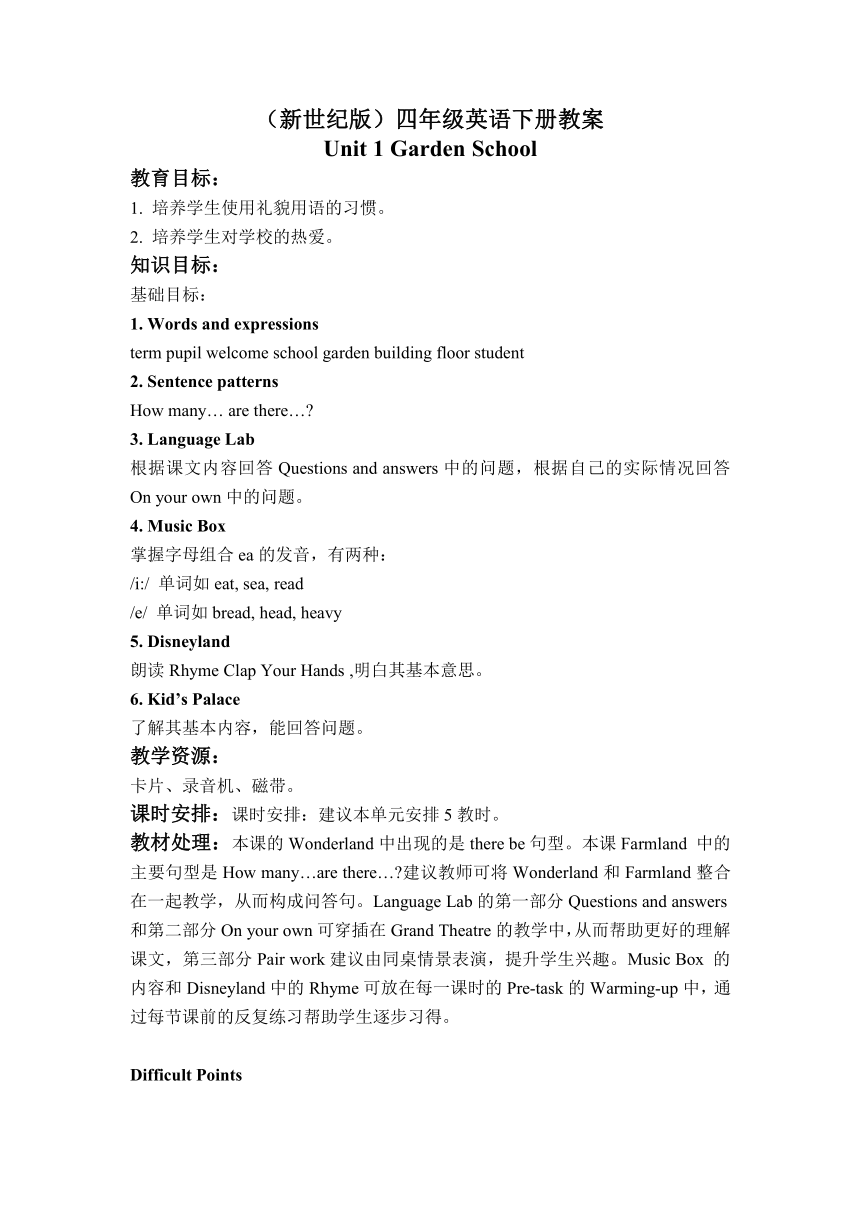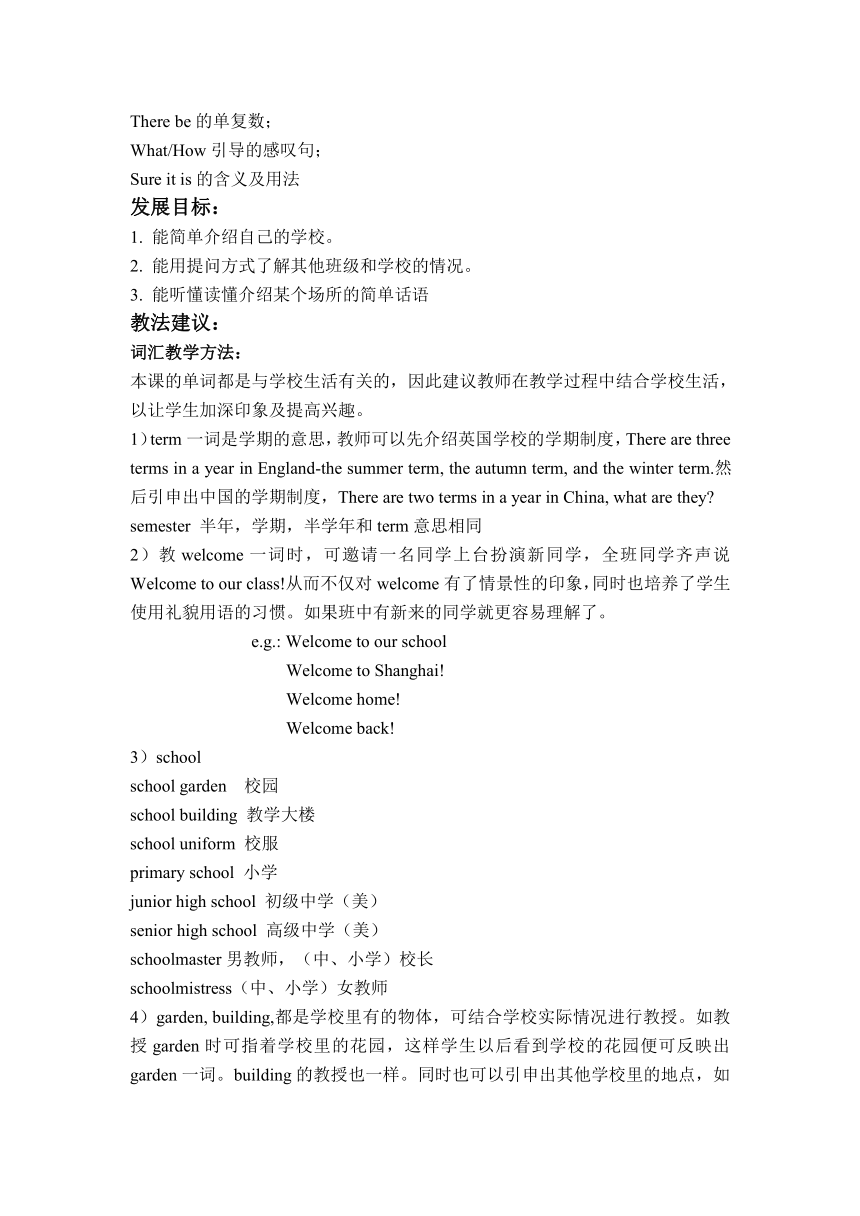(新世纪版)四年级英语下册教案 Unit 1(3)
文档属性
| 名称 | (新世纪版)四年级英语下册教案 Unit 1(3) |

|
|
| 格式 | zip | ||
| 文件大小 | 18.0KB | ||
| 资源类型 | 教案 | ||
| 版本资源 | 新世纪版 | ||
| 科目 | 英语 | ||
| 更新时间 | 2012-03-13 19:43:32 | ||
图片预览


文档简介
(新世纪版)四年级英语下册教案
Unit 1 Garden School
教育目标:
1. 培养学生使用礼貌用语的习惯。
2. 培养学生对学校的热爱。
知识目标:
基础目标:
1. Words and expressions
term pupil welcome school garden building floor student
2. Sentence patterns
How many… are there…
3. Language Lab
根据课文内容回答Questions and answers中的问题,根据自己的实际情况回答On your own中的问题。
4. Music Box
掌握字母组合ea的发音,有两种:
/i:/ 单词如eat, sea, read
/e/ 单词如bread, head, heavy
5. Disneyland
朗读Rhyme Clap Your Hands ,明白其基本意思。
6. Kid’s Palace
了解其基本内容,能回答问题。
教学资源:
卡片、录音机、磁带。
课时安排:课时安排:建议本单元安排5教时。
教材处理:本课的Wonderland中出现的是there be句型。本课Farmland 中的主要句型是How many…are there… 建议教师可将Wonderland和Farmland整合在一起教学,从而构成问答句。Language Lab的第一部分Questions and answers和第二部分On your own可穿插在Grand Theatre的教学中,从而帮助更好的理解课文,第三部分Pair work建议由同桌情景表演,提升学生兴趣。Music Box 的内容和Disneyland中的Rhyme可放在每一课时的Pre-task的Warming-up中,通过每节课前的反复练习帮助学生逐步习得。
Difficult Points
There be的单复数;
What/How引导的感叹句;
Sure it is的含义及用法
发展目标:
1. 能简单介绍自己的学校。
2. 能用提问方式了解其他班级和学校的情况。
3. 能听懂读懂介绍某个场所的简单话语
教法建议:
词汇教学方法:
本课的单词都是与学校生活有关的,因此建议教师在教学过程中结合学校生活,以让学生加深印象及提高兴趣。
1)term一词是学期的意思,教师可以先介绍英国学校的学期制度,There are three terms in a year in England-the summer term, the autumn term, and the winter term.然后引申出中国的学期制度,There are two terms in a year in China, what are they
semester 半年,学期,半学年和term意思相同
2)教welcome一词时,可邀请一名同学上台扮演新同学,全班同学齐声说Welcome to our class!从而不仅对welcome有了情景性的印象,同时也培养了学生使用礼貌用语的习惯。如果班中有新来的同学就更容易理解了。
e.g.: Welcome to our school
Welcome to Shanghai!
Welcome home!
Welcome back!
3)school
school garden 校园
school building 教学大楼
school uniform 校服
primary school 小学
junior high school 初级中学(美)
senior high school 高级中学(美)
schoolmaster男教师,(中、小学)校长
schoolmistress(中、小学)女教师
4)garden, building,都是学校里有的物体,可结合学校实际情况进行教授。如教授garden时可指着学校里的花园,这样学生以后看到学校的花园便可反映出garden一词。building的教授也一样。同时也可以引申出其他学校里的地点,如食堂cafeteria,图书馆library等。
5)floor VS storey
floor和storey都指楼房的“层”。floor指具体的一层或用于表示“第几层”,如:the fifth floor第五层;storey用于表示“几层”的(楼)房。如:a one storey house平房。英美在用floor表示“第几层” 楼层时意思并不一样。
British English American English Chinese
the second floor the third floor 三楼
the first floor the second floor 二楼
the ground floor the first floor 一楼、底层
6)pupil, student都有“学生”的意思。不同的是,pupil特指小学生。通过对这两个词的辨析,为学生日后的正确使用打基础。
7)talk with 与某人谈话
talk about 谈论关于
8)随后教师可引导学生用新学的单词造句。如:
The computer room is on the fourth floor.
I’m in… school.
I’m a pupil of Grade Four.
9)最后教师可组织学生通过问答句来巩固所学的单词,如:
Where is English teachers’ office On the third floor.
10)in all 总共
句型教学方法:
1) 教师可先出示词汇短语desks/ in the study, fridges/ in the kitchen,让学生用There are造句。然后再给出单数词组a pupil/ classroom,从而引申出there is的句型。然后通过单复数词组的变化,让学生进行there is与there are之间的转换,从而更明晰两者的区别。
2)在刚才教there be句型的基础上,再引申出他们的问句How many…are there… 将刚才所造的句子用how many问一遍。要注意对how many一般都以are there的复数形式出现的解释。
3)以what引导的感叹句的用法:what(a)+ adj. + n. +(it is)! 通过让学生造句巩固对其用法顺序的印象。再引申出how引导的感叹句的用法:how + adj. + the + n. + is! 同样通过造句来巩固。最后将两者交叉使用,同一事物分别用两个句型来表示,如:
What a beautiful park it is! = How beautiful the park is!
有条件的班级教师可归纳到 “两型七式”:
两种句型是以what开头的句型和以how开头的句型,
七种格式是
①what + a + adj. + N+ S +V
例:What a nice book it is!
②what + an + adj. +N +S +V
例:What an interesting movie it is!
③what + adj. + N(不可数)+ S +V
例:What cold water it is!
④what + adj. + N(可数名词复数形式)+ S+V
例:What clever boys they are!
⑤how + adj.+ S +V 例:How clever the boy is!
⑥how + adv. + S + V 例:How fast the fish swims!
⑦ how + adj. + a/ an + N + S+V 例:How old a building that is!
(学生只要掌握其中的部分即可)
4)Sure it is.
部分倒装句,强调sure。
制造不同情景让学生使用到这句话,从而使其明白这句话的适用场合。
5)关注有关 “of”和“from”的短语表达教学。
如:the first day of the new term
I am a pupil of Grade Four; a new pupil from Canada
I am a pupil. I am in Grade Four. == I am a pupil of Grade Four.
He’s a boy. He’s 10 years old. == He’s a boy of ten. == He’s a ten-year-old boy.
课文教学方法:
1)教师可先制造一个新同学到来的场景,启发学生想些欢迎以及打招呼的用语,从而引出本课要学习的礼貌用语:
Glad to meet you. Glad to meet you, too.
Welcome to our school.
2)接着教师可将话题引至对学校的介绍上,比如介绍自身学校的设施,如:
classroom, floor, room, school, building等。
3)随后正式带学生开始理解课文,教师可让学生先跟录音仿读课文。课文中的主要单词和句型在前面的教学中都已解决,因此学生对课文内容很容易掌握。
4)接着教师可在情景中为学生分析课文,并结合Language Lab中的Questions and Answers,通过让学生回答这些问题,帮助他们加深对课文的理解;同时完成On Your Own中的题目。
5)然后,教师可邀请学生上台表演课文内容,并让全班同学进行配对的pair work,从而让所有学生都参与进来。
6)最后教师可组织学生阅读教材中提供的辅助语言材料Story: Mark’s Pet,增加语言的输入量。
Unit 1 Garden School
教育目标:
1. 培养学生使用礼貌用语的习惯。
2. 培养学生对学校的热爱。
知识目标:
基础目标:
1. Words and expressions
term pupil welcome school garden building floor student
2. Sentence patterns
How many… are there…
3. Language Lab
根据课文内容回答Questions and answers中的问题,根据自己的实际情况回答On your own中的问题。
4. Music Box
掌握字母组合ea的发音,有两种:
/i:/ 单词如eat, sea, read
/e/ 单词如bread, head, heavy
5. Disneyland
朗读Rhyme Clap Your Hands ,明白其基本意思。
6. Kid’s Palace
了解其基本内容,能回答问题。
教学资源:
卡片、录音机、磁带。
课时安排:课时安排:建议本单元安排5教时。
教材处理:本课的Wonderland中出现的是there be句型。本课Farmland 中的主要句型是How many…are there… 建议教师可将Wonderland和Farmland整合在一起教学,从而构成问答句。Language Lab的第一部分Questions and answers和第二部分On your own可穿插在Grand Theatre的教学中,从而帮助更好的理解课文,第三部分Pair work建议由同桌情景表演,提升学生兴趣。Music Box 的内容和Disneyland中的Rhyme可放在每一课时的Pre-task的Warming-up中,通过每节课前的反复练习帮助学生逐步习得。
Difficult Points
There be的单复数;
What/How引导的感叹句;
Sure it is的含义及用法
发展目标:
1. 能简单介绍自己的学校。
2. 能用提问方式了解其他班级和学校的情况。
3. 能听懂读懂介绍某个场所的简单话语
教法建议:
词汇教学方法:
本课的单词都是与学校生活有关的,因此建议教师在教学过程中结合学校生活,以让学生加深印象及提高兴趣。
1)term一词是学期的意思,教师可以先介绍英国学校的学期制度,There are three terms in a year in England-the summer term, the autumn term, and the winter term.然后引申出中国的学期制度,There are two terms in a year in China, what are they
semester 半年,学期,半学年和term意思相同
2)教welcome一词时,可邀请一名同学上台扮演新同学,全班同学齐声说Welcome to our class!从而不仅对welcome有了情景性的印象,同时也培养了学生使用礼貌用语的习惯。如果班中有新来的同学就更容易理解了。
e.g.: Welcome to our school
Welcome to Shanghai!
Welcome home!
Welcome back!
3)school
school garden 校园
school building 教学大楼
school uniform 校服
primary school 小学
junior high school 初级中学(美)
senior high school 高级中学(美)
schoolmaster男教师,(中、小学)校长
schoolmistress(中、小学)女教师
4)garden, building,都是学校里有的物体,可结合学校实际情况进行教授。如教授garden时可指着学校里的花园,这样学生以后看到学校的花园便可反映出garden一词。building的教授也一样。同时也可以引申出其他学校里的地点,如食堂cafeteria,图书馆library等。
5)floor VS storey
floor和storey都指楼房的“层”。floor指具体的一层或用于表示“第几层”,如:the fifth floor第五层;storey用于表示“几层”的(楼)房。如:a one storey house平房。英美在用floor表示“第几层” 楼层时意思并不一样。
British English American English Chinese
the second floor the third floor 三楼
the first floor the second floor 二楼
the ground floor the first floor 一楼、底层
6)pupil, student都有“学生”的意思。不同的是,pupil特指小学生。通过对这两个词的辨析,为学生日后的正确使用打基础。
7)talk with 与某人谈话
talk about 谈论关于
8)随后教师可引导学生用新学的单词造句。如:
The computer room is on the fourth floor.
I’m in… school.
I’m a pupil of Grade Four.
9)最后教师可组织学生通过问答句来巩固所学的单词,如:
Where is English teachers’ office On the third floor.
10)in all 总共
句型教学方法:
1) 教师可先出示词汇短语desks/ in the study, fridges/ in the kitchen,让学生用There are造句。然后再给出单数词组a pupil/ classroom,从而引申出there is的句型。然后通过单复数词组的变化,让学生进行there is与there are之间的转换,从而更明晰两者的区别。
2)在刚才教there be句型的基础上,再引申出他们的问句How many…are there… 将刚才所造的句子用how many问一遍。要注意对how many一般都以are there的复数形式出现的解释。
3)以what引导的感叹句的用法:what(a)+ adj. + n. +(it is)! 通过让学生造句巩固对其用法顺序的印象。再引申出how引导的感叹句的用法:how + adj. + the + n. + is! 同样通过造句来巩固。最后将两者交叉使用,同一事物分别用两个句型来表示,如:
What a beautiful park it is! = How beautiful the park is!
有条件的班级教师可归纳到 “两型七式”:
两种句型是以what开头的句型和以how开头的句型,
七种格式是
①what + a + adj. + N+ S +V
例:What a nice book it is!
②what + an + adj. +N +S +V
例:What an interesting movie it is!
③what + adj. + N(不可数)+ S +V
例:What cold water it is!
④what + adj. + N(可数名词复数形式)+ S+V
例:What clever boys they are!
⑤how + adj.+ S +V 例:How clever the boy is!
⑥how + adv. + S + V 例:How fast the fish swims!
⑦ how + adj. + a/ an + N + S+V 例:How old a building that is!
(学生只要掌握其中的部分即可)
4)Sure it is.
部分倒装句,强调sure。
制造不同情景让学生使用到这句话,从而使其明白这句话的适用场合。
5)关注有关 “of”和“from”的短语表达教学。
如:the first day of the new term
I am a pupil of Grade Four; a new pupil from Canada
I am a pupil. I am in Grade Four. == I am a pupil of Grade Four.
He’s a boy. He’s 10 years old. == He’s a boy of ten. == He’s a ten-year-old boy.
课文教学方法:
1)教师可先制造一个新同学到来的场景,启发学生想些欢迎以及打招呼的用语,从而引出本课要学习的礼貌用语:
Glad to meet you. Glad to meet you, too.
Welcome to our school.
2)接着教师可将话题引至对学校的介绍上,比如介绍自身学校的设施,如:
classroom, floor, room, school, building等。
3)随后正式带学生开始理解课文,教师可让学生先跟录音仿读课文。课文中的主要单词和句型在前面的教学中都已解决,因此学生对课文内容很容易掌握。
4)接着教师可在情景中为学生分析课文,并结合Language Lab中的Questions and Answers,通过让学生回答这些问题,帮助他们加深对课文的理解;同时完成On Your Own中的题目。
5)然后,教师可邀请学生上台表演课文内容,并让全班同学进行配对的pair work,从而让所有学生都参与进来。
6)最后教师可组织学生阅读教材中提供的辅助语言材料Story: Mark’s Pet,增加语言的输入量。
同课章节目录
- Unit 1 Garden School
- Unit 2 Calenda
- Unit 3 A Game—Who’s My Mind Reader?
- Unit 4 Where’s Norman’s Ticket?
- Unit 5 What’s Going On?
- Unit 6 The Noisy Band
- Unit 7 How Does It Feel?
- Unit 8 What About Yours?
- Unit 9 What’s the Weather Like?
- Unit 10 What Are You Going to Do?
- Unit 11 My Tail
- Unit 12 Is It Going to Rain Tomorrow?
